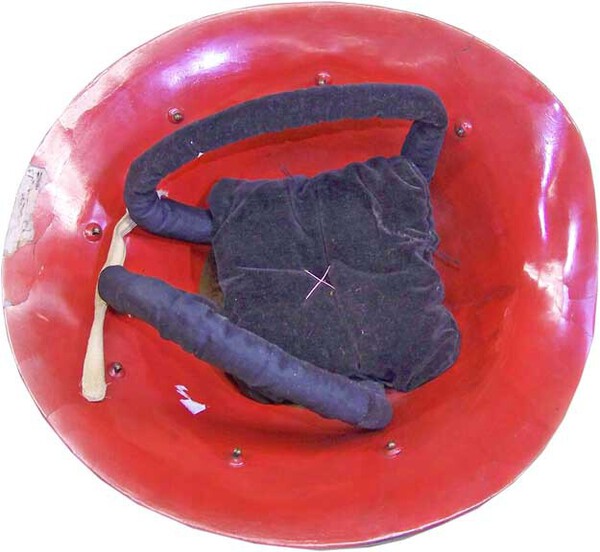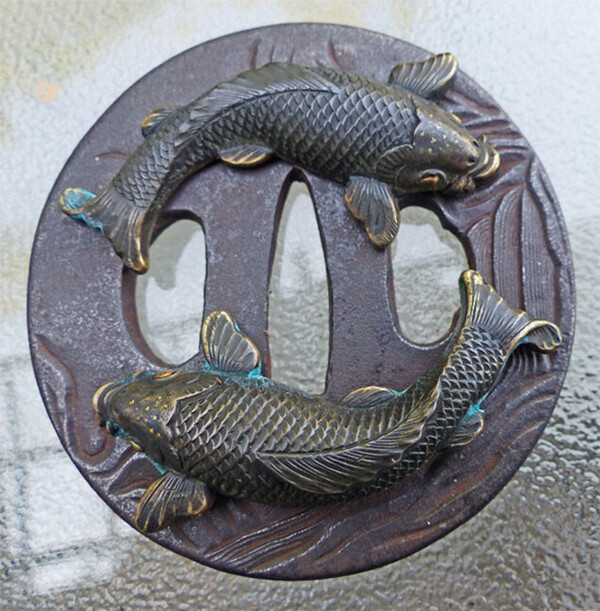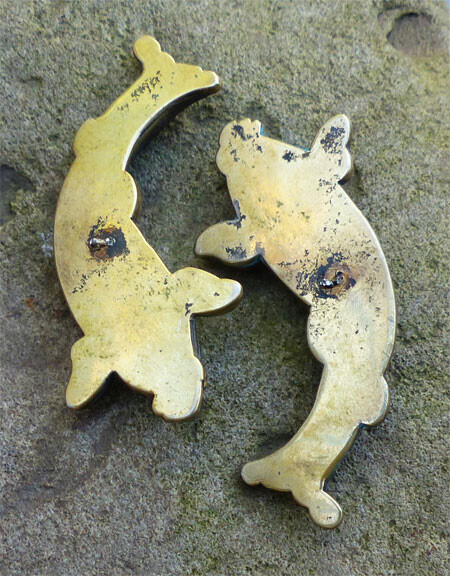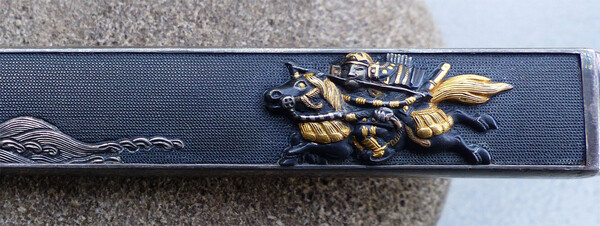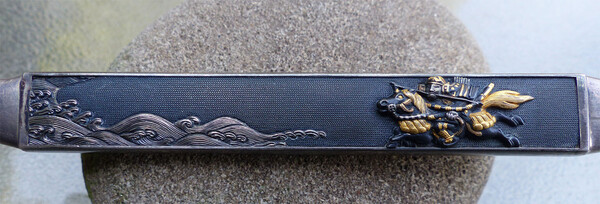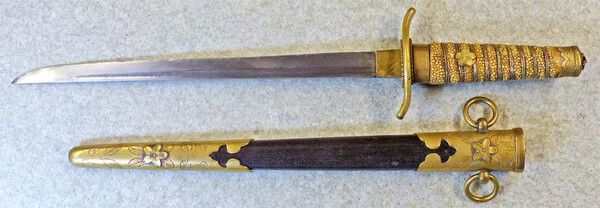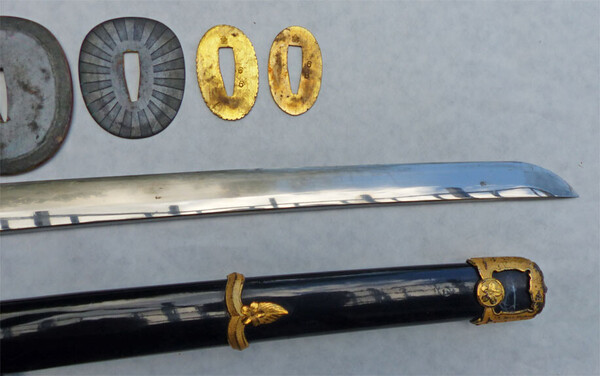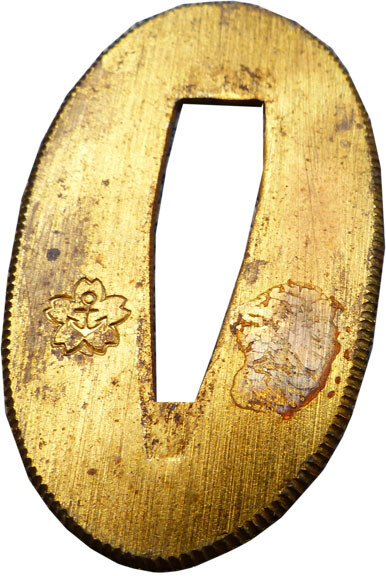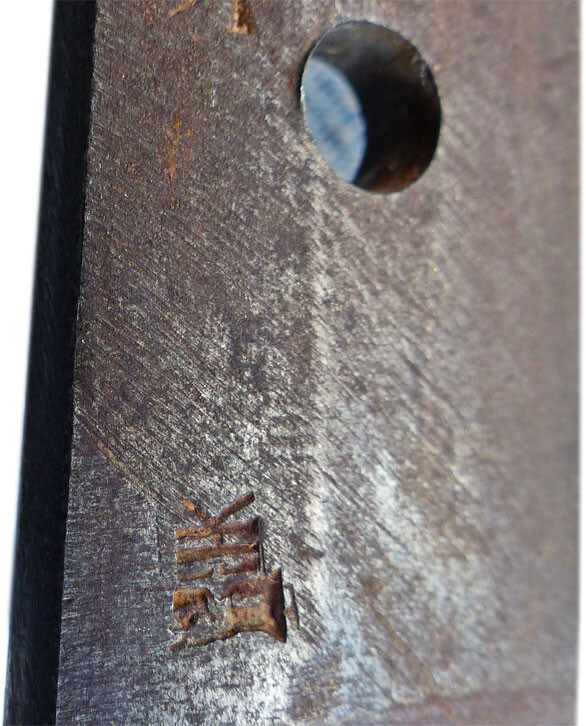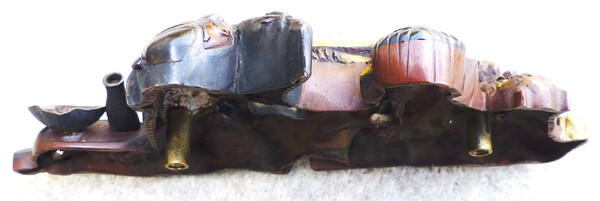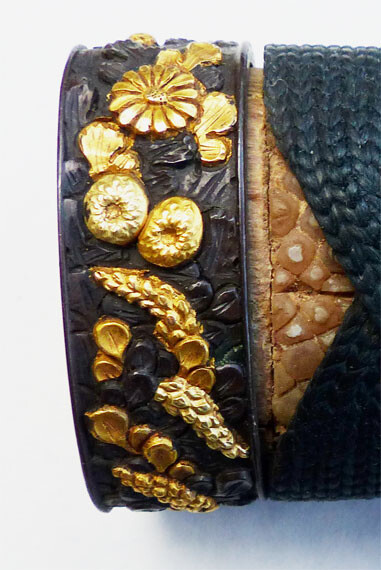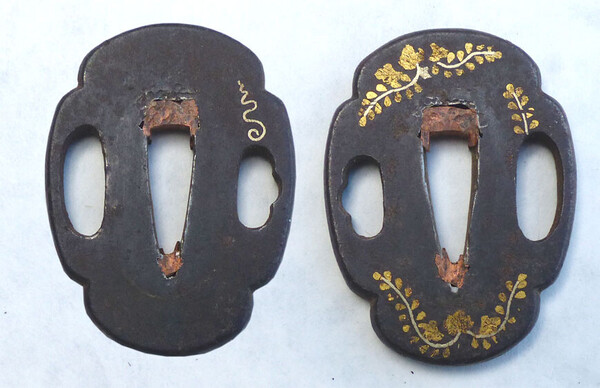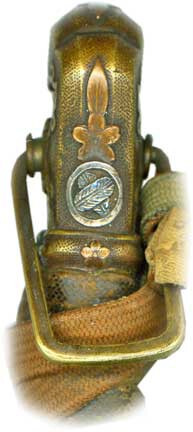
Tonkotsu
Members-
Posts
93 -
Joined
-
Last visited
-
Days Won
6
Content Type
Profiles
Forums
Events
Store
Downloads
Gallery
Everything posted by Tonkotsu
-
Thank everyone for the information. What do you make of the tsuba. I am not quite sure if the design is intentional or random. The piece is iron. The saya has been painted with flat black paint. I wonder if it was covered with leather at one time.
-
I know nothing about this sword. I n fact I really know nothing about any of the swords that I have. My main interest is Japanese mixed metal work and the techniques used to create them. I have been a member of Ford's Following the Iron Brush for over a decade. Any information on this sword would be helpful. Thanks, Dick
-
Here is a pair of large 5.4 cm shakudo and gold fish menuki. These are very nice menuki except these have the reverse covered with a gold plate. Should The plate be removed or would it be best to leave them alone. I am afraid to heat them because it might destroy the patena and gold. Thanks, Dick
-
Here is a silver kiseru with a very high quality kozuka panel on each side. The panels are shakudo, silver, copper and gold. All work is in relief on a very fine nanakoji surface. The Kozuka panels are Edo made into a kiseru during the Meiji period possibly for the tourist trade. Dick
-
Kai-Gunto bring back Dress Sword and Dirk group
Tonkotsu replied to Tonkotsu's topic in Military Swords of Japan
Thank you to everyone for your comments and information. Jareth, The group I bought included two photograph albums. One of the albums contained pictures of Japan where Gibson was stationed until December 1945. In the album with the Japan occupation photos is a photograph of a Japanese Naval officer identified in Japanese wearing a dirk. Next to the photo Gibson wrote that the officer was the owner of the swords, dirk, medals, belt buckle and hat badge that he sent home. Dick -
Here is the Imperial Japanese Navy Dirk from the group of items brought home by PFC Leroy Stanley Gibson USMCR. I bought the group years ago from a dealer who bought it from the family. Gibson purchased the group from a Japanese family while he was on occupation duty right after the war. I have a ID'ed photo of the naval officer that was in the photo albums that went with the Gibson group. A slightly better quality than the average wartime dirk. Thanks, Dick
-
- 1
-

-
Kai-Gunto bring back Dress Sword and Dirk group
Tonkotsu replied to Tonkotsu's topic in Military Swords of Japan
-
Here is the Kai-Gunto from the group of items brought home by PFC Leroy Stanley Gibson USMCR. I bought the group years ago from a dealer who bought it from the family. Gibson purchased the group from a Japanese family while he was on occupation duty right after the war. I have a ID'ed photo of the naval officer that was in the photo albums that went with the Gibson group. If I need to take any additional photos please let me know. Thanks, Dick
-
Here is a WW2 Model 1883 Japanese Naval Officer's dress sword in mint condition. This is part of a group that belonged to PFC Leroy Stanley Gibson USMCR. Gibson was wounded on Roi-Namur Atol and fought on Okinawa Island. At the end of the war he served occupation duty in Japan where he bought this group that belonged to a Japanese Naval officer from the officers family.
-
Large mixed metal Kanemono neck wrestling Emma-O
Tonkotsu replied to Tonkotsu's topic in Other Japanese Arts
Darrel, The sake jug and the bowl are riveted in place. I totally agree that it would be much easier to solder everything in place. I have an even better Edo tobacco pouch in the same style that is signed. I will post it soon. Thanks, Dick -
Large mixed metal Kanemono neck wrestling Emma-O
Tonkotsu replied to Tonkotsu's topic in Other Japanese Arts
Here are a couple additional views of the Kanemono. Because of the kinkarakawa leather I date this pouch in the late Edo period possibly 1850-1870. -
Here is a tanto with all of the fittings made of antler. The blade is unsigned but the kozuka is signed. The hamon is visible in the photograph. I have enjoyed the quality of the carving. Any information you could give me would be greatly appreciated since my knowledge about Japanese swords is very limited. I can take additional photographs if necessary. Thank you, Dick
-
Hi Geraint, The length of the blade from the munemachi to the tip is 31.5 cm. Dick
-
Steve, Is there any possibility that this sword is actually made by Hizen kuni jū Tadakiyo?
-
Here is a very small wakizashi with a total length of 43.5 c or 17 1/4". The hamon is straight. I photographed everything so you can get an idea of the quality. There is a rust spot at the boshi which is stable. The mei is hard to see so I have tried different ways of presenting it. Any information you can give me about this sword would be very much appreciated. Thank you. Dick
-
-
Piers, Here is the matchlock with the barrel pulled. No markings but lots of rust. The bore measures at 12mm.
-
Thank you for the information. I wasn't sure if the bird was a hawk or eagle. I thought the vegetable was an eggplant. I had no idea the theme was hatsuyume so thank you again for the help. Dick
-
Here is what I believe to be a finely sculpted unsigned Tsuba. The front shows a eagle flying over Mount Fuji. The soft metal inlayed into the iron to form the eagle consists of shibuishi and gold. The snow on Mount Fuji is silver. The reverse shows a vegetable inlayed in Shakudo and shibuishi.
-
Here is a large mixed metal Kanemono or clasp (4 ½”X 2”-110mm x 50mm) for a pouch (8 ½” X 3 ¾”-210mm X 95mm) showing the King of Hell, Emma-O, neck wrestling with what appears to be a man casually smoking his pipe while totally unperturbed. Emma-o is backed up by a two oni or devils who don't seem to be having much effect. The point of this piece is clearly meant to be humorous. The Kanemono is shakudo, gold and silver. In the British Museum there is a Kano school painting showing Asahina (朝夷) in Hell. Known for his great strength he vanquishes the demons who compete with him - one in neck wrestling. Then he is made the honored guest of Emma-O and all of the demons are made to serve him. Emma-ō, in Japanese Buddhist mythology, the overlord of hell (Jigoku), corresponding to the Indian deity Yama. He judges the souls of men, while his sister judges the souls of women. The sinner is sent to one of the 16 regions of fire or ice assigned him by Emma-ō for a fixed period of time until the next rebirth, unless saved by the prayers of the living, in which case he is reborn either on earth or in a heavenly paradise. Emma-ō is usually represented with a fierce expression, wearing a Chinese judge’s cap and holding his mace of office. This hand-colored photo from the 1870s shows two men battling it out over an old Japanese party game. The idea was to link yourselves neck-to-neck with a loop of old cloth or rope, and, while in a seated position, try to pull your opponent toward you, tumbling them into your lap or the floor.
-
-
Thank you very much for the information! Dick
-
Thank you all for the information. What does the writing on the nakago say? Thank you again, Dick








